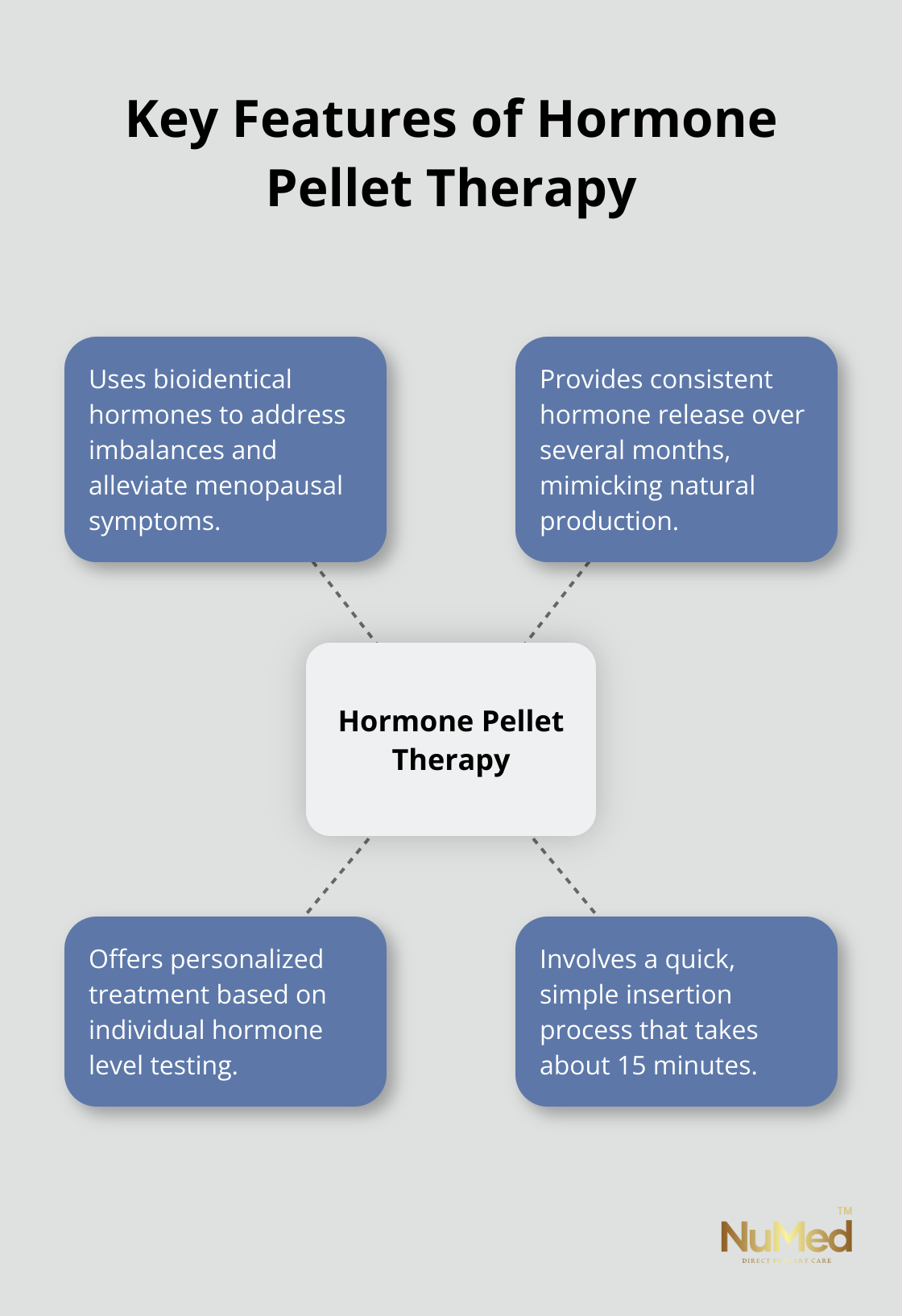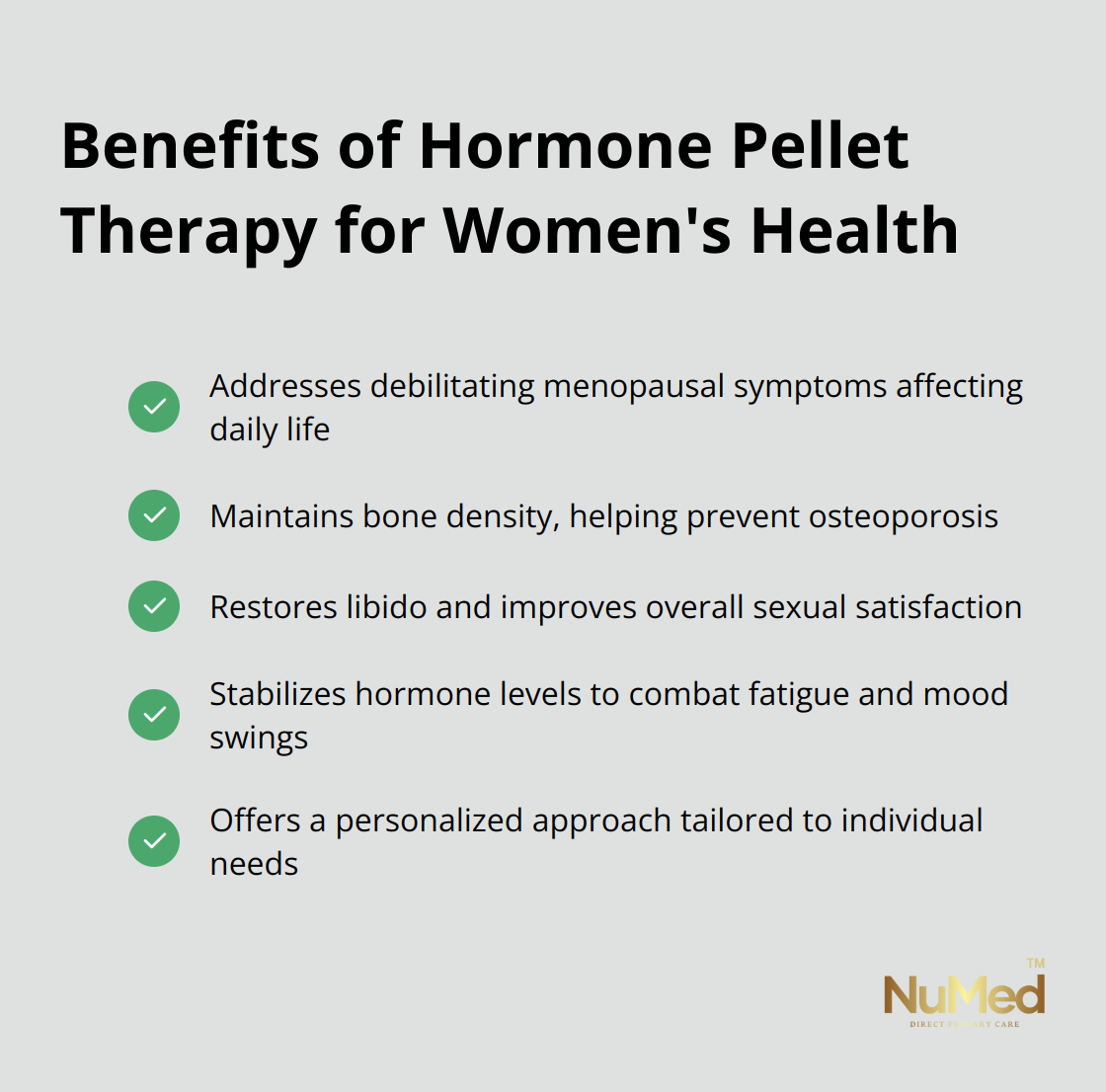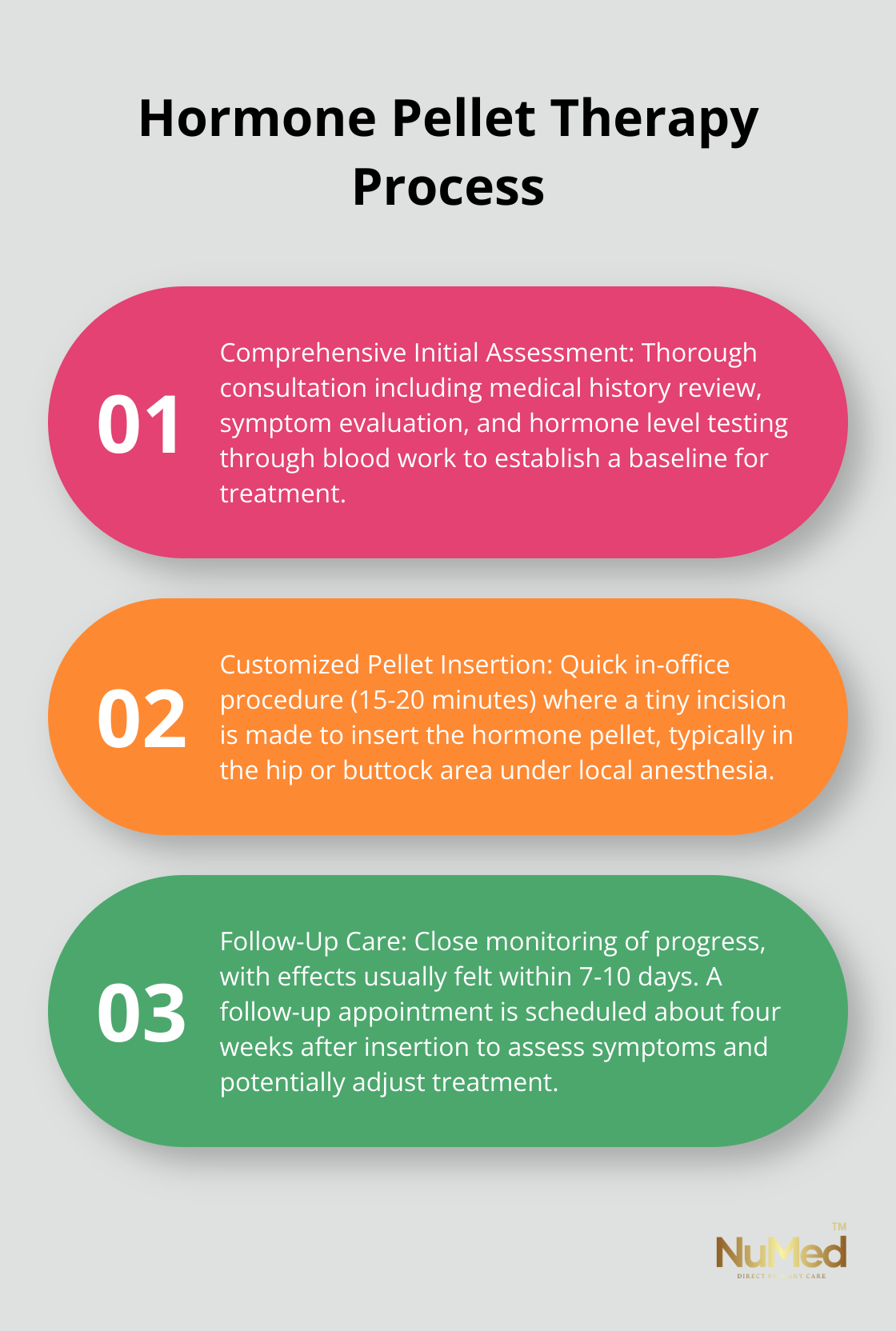At NuMed DPC, we’ve seen firsthand how hormone pellet therapy for women can transform lives. This innovative approach to hormone replacement offers a range of benefits for women’s health, particularly during menopause.
Hormone pellet therapy uses bioidentical hormones to address imbalances and alleviate symptoms like hot flashes, mood swings, and decreased libido. In this post, we’ll explore the science behind this treatment and its potential to improve overall well-being for women.
What Is Hormone Pellet Therapy?
The Basics of Pellet Therapy
Hormone pellet therapy represents a modern approach to hormone replacement that has gained traction among women seeking relief from menopausal symptoms. This method involves the insertion of small, rice-sized pellets under the skin to deliver a steady stream of hormones.
A Unique Delivery System
Unlike traditional hormone replacement methods (which often require daily pills or regular injections), pellet therapy provides a consistent hormone release over several months. This approach aims to mimic the body’s natural hormone production, which may lead to fewer side effects and more stable hormone levels.
The pellets, typically composed of estradiol or testosterone, are placed in the fatty tissue beneath the skin during a quick, in-office procedure. As the body absorbs the pellet, it releases small, physiologic doses of hormones directly into the bloodstream.

Bioidentical Hormones: A Natural Alternative
One of the key aspects of hormone pellet therapy is the use of bioidentical hormones. However, it’s important to note that bioidentical hormones marketed as “natural” aren’t safer than hormones used in traditional hormone therapy, and there’s no proof they are safer or more effective.
Personalized Treatment Approach
Hormone therapy should be tailored to each individual’s needs. Before starting pellet therapy, hormone level testing through a blood test is conducted to ensure proper dosage. This personalized approach allows for effective addressing of specific symptoms and health concerns.
The North American Menopause Society reports that individualized hormone therapy can significantly improve quality of life for many women experiencing menopausal symptoms. With pellet therapy, hormone levels can be fine-tuned over time, adjusting the treatment as needed based on symptom relief and follow-up testing.
The Insertion Process
The pellet insertion process is relatively simple and quick (usually taking about 15 minutes). A healthcare provider makes a small incision in the hip or buttock area under local anesthesia. The pellet is then inserted through this incision, which is closed with surgical glue or a small bandage.
As we move forward, let’s explore the specific benefits that hormone pellet therapy can offer for women’s health, particularly in addressing menopausal symptoms and improving overall well-being.
How Hormone Pellet Therapy Benefits Women’s Health
Tackling Menopausal Symptoms
Hormone replacement therapy (HRT) replenishes women with ovarian hormones diminished during the natural menopausal transition to alleviate associated symptoms. This treatment effectively addresses debilitating menopausal symptoms that affect daily life and overall well-being.

Strengthening Bones and Preventing Osteoporosis
Osteoporosis presents a major concern for postmenopausal women. Hormone pellet therapy plays a vital role in maintaining bone density. Regular bone density scans can track improvements over time.
Revitalizing Sexual Health
Many women experience a decline in sexual function during menopause. Hormone pellet therapy can restore libido and improve overall sexual satisfaction.
Elevating Energy and Mood
Fatigue and mood swings commonly plague women during menopause. Hormone pellet therapy addresses these issues by stabilizing hormone levels.
Personalized Treatment Approach
Hormone pellet therapy doesn’t offer a one-size-fits-all solution. Healthcare providers conduct thorough evaluations to determine if this treatment suits each individual patient. They also emphasize the importance of lifestyle factors (such as diet and exercise) in conjunction with hormone therapy for optimal results.
Regular follow-ups and hormone level monitoring prove essential to ensure the therapy continues to meet patients’ needs. Experts recommend scheduling check-ups every 3-4 months to assess progress and make any necessary adjustments to the treatment plan.
As we explore the benefits of hormone pellet therapy, it’s important to understand the process involved in this treatment. Let’s now examine the steps from initial consultation to ongoing care in hormone pellet therapy.
How Hormone Pellet Therapy Works
Comprehensive Initial Assessment
The hormone pellet therapy process starts with a thorough consultation. This visit includes an in-depth review of your medical history, current symptoms, and health goals. This information helps determine if hormone pellet therapy is the right choice for you.
A critical component of this assessment is hormone level testing. A blood test measures your current hormone levels, including estrogen, testosterone, and thyroid hormones. This data serves as a baseline for your treatment plan.
Customized Pellet Insertion
After analyzing your test results and confirming that hormone pellet therapy is appropriate, the insertion procedure is scheduled. This quick, in-office treatment typically takes about 15-20 minutes.
Local anesthesia numbs a small area on your hip or buttock. A tiny incision is made, and the custom-compounded hormone pellet is inserted. The incision is so small that it usually requires only a small bandage (no stitches necessary).
Follow-Up Care
After the pellet insertion, your progress is closely monitored. Most patients start feeling the effects within 7-10 days, but it can take up to two weeks for the full benefits to manifest.
A follow-up appointment is scheduled about four weeks after the insertion. During this visit, your symptoms are assessed, and another blood test may be conducted to check your hormone levels. This allows for fine-tuning of your treatment if needed.

Treatment Frequency
The frequency of pellet insertions varies from person to person. On average, women need new pellets every 3-4 months. However, some patients may require more frequent treatments, while others might go longer between insertions.
This schedule is based on your individual response to the therapy, symptom relief, and hormone level tests. The goal is to maintain stable hormone levels throughout your treatment cycle. Unlike oral medications or creams, which may result in peaks and valleys of your hormone levels, pellets provide a more consistent and sustained release.
Ongoing Optimization
As you progress through your hormone pellet therapy journey, your treatment plan will continue to be adjusted and optimized. This ongoing care ensures that you receive the maximum benefits from this innovative approach to hormone replacement.
Final Thoughts
Hormone pellet therapy for women offers a promising solution for those seeking relief from menopausal symptoms and improved overall health. This innovative approach provides numerous benefits, including alleviation of hot flashes, mood swings, and decreased libido. It also contributes to bone density maintenance, sexual function enhancement, and energy level improvement.
The personalized nature of hormone pellet therapy stands out as a key advantage. Each treatment plan adapts to the individual’s specific needs, based on comprehensive hormone level testing and ongoing monitoring. This customized approach ensures women receive the right hormone balance to address their unique symptoms and health concerns.
Women who want to explore hormone pellet therapy and other innovative healthcare solutions should consider NuMed Direct Primary Care. Our approach focuses on addressing the root causes of health issues and providing tailored treatments to optimize overall well-being. We encourage women to take charge of their health and explore available options (including hormone pellet therapy) as part of a holistic approach to managing menopause and improving quality of life.
















